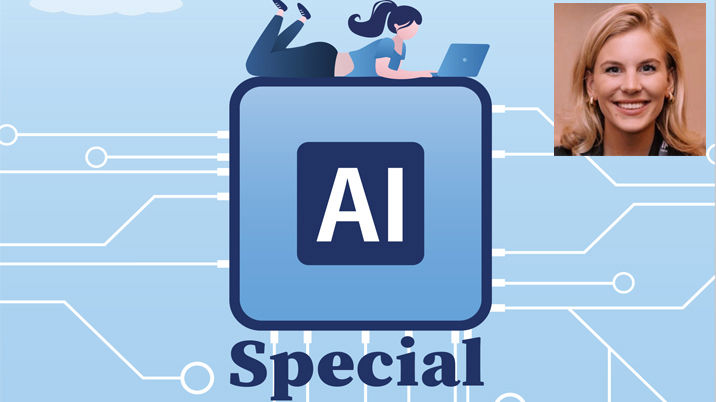
Q: What have been your key learnings?
A: There are so many, I could write a book on what we have learnt but I have picked out some of my favourites that are not talked about as much.
The first key learning is that strategy matters. Our cohesive AI strategy has been essential. Our approach is built on these four key pillars that support each other to unlock AI’s potential for today while preparing us for the future — and keeping humans at the centre:
- Audiences & Ecosystem. Understanding how GenAI is shaping our audiences’ needs and habits, allowing us to adapt and remain relevant as expectations evolve.
- Learning & Transformation. Developing the skills and ways of working needed within our teams to harness GenAI’s potential. As AI advances, continuous learning and adaptability become critical.
- Workflow Productivity. Identifying workflow use-cases where GenAI can add genuine value, eg. enabling us to produce faster or enhance quality.
- Product Innovation. Leveraging technical advancements to deliver product innovations that benefit our audiences in daily life.
Our learnings:
- Generating excitement is easy; sustaining transformation is the challenge. Beyond the initial hype, true transformation requires ongoing effort, as everyone is deeply rooted in established habits. The key is to reward curiosity, maintain momentum, and ensure leadership consistently supports AI transformation through clear communication and aligned OKRs.
- Productionising is essential. We have come to understand that without moving from experimentation to full technical production, we will inevitably hit a ceiling in workflow efficiencies. So, we need to build internal tools and products to help scale the usage.
- AI fuels creativity, but human insight drives innovation. AI has opened new ways to explore ideas, streamline tasks, and reimagine content, but true innovation relies on human insight. We have learned that AI is most powerful when it enhances our creative process rather than replaces it.
- AI unlocks new possibilities for experimentation. AI makes it easier to quickly test new ideas, even without specialised skills. We use GPTs to test ideas quite a lot and I recently built an online Sudoku game with the ChatGPT o1 models and Google Colab — and believe me when I say that I am no developer.
However, building lasting products still requires a deep understanding of the topic and a lot of work.
Q: In which use-cases have you had the best results?
A: One transformative use-case for us has been the repurposing and reformatting of existing content and thereby using GenAI to unlock our vast archives.
- Why is this transformative? This approach aligns with customer demand for diverse content formats and helps us keep up in a fast-paced world. Editors now juggle roles across video, social media, magazines, websites, newsletters, and more. AI repurposing might help us get closer to that challenge by enabling efficient content repurposing across platforms, helping us scale while protecting our ‘moat’ and brand.
- What are we doing? Through focused training and external support, content specialists now experiment with AI for tasks like adapting articles for Apple News, transforming podcasts into magazine specials, and creating multimodal formats, including video scripts from other pieces.
- What next? It is early days, but we are now productionising these efforts, using feedback from the repurposing initiative to develop new tools that enhance workflows, built iteratively with content creators. For example, feedback is informing a new tool that will allow writers to create first drafts with generative AI, trained solely on our content archives — enabling efficiency, brand consistency, and responsiveness to content demands.
- Challenges we are facing. One challenge is finding the right use-cases where productionising efforts make sense and where AI technology is mature enough to deliver consistent results — all while making time to develop these use-cases thoughtfully and foster positive sentiment.
Three best practice top tips
1. Keep AI aligned with real workflow needs. For AI in editorial workflows, collaborate closely with editors and AI experts — don’t build solutions in a vacuum. Editors are essentially the users of such tools, so involving them directly is key to ensuring relevance, practicality, and trust. Avoid developing features that may soon become obsolete; instead, focus on adaptable, long-term goals as AI capabilities evolve rapidly, eg. who knows what today’s cutting-edge features, like video AI tools, will look like a year from now?
2. Democratise AI through access and engagement across the company. We are committed to making AI accessible for everyone with a few key initiatives. That drives company-wide adoption and facilitates finding the big wins.
How?
- Central funding for tools: ensuring access to essential AI tools across departments.
- Guardrails and approved tools: providing guidance with curated lists of effective, safe tools and guidelines.
- Flexible training: offering both self-serve and expert-led sessions for skill-building.
- Communities of practice: eight groups dedicated to sharing knowledge and support.
- Regular communication: keeping everyone up-to-date on tools, developments, and best practices.
3. AI is not a magic wand, but a powerful tool when used right. AI isn’t a universal fix — it’s a tool that, when thoughtfully applied to the right challenges, can drive real value. Strategic deployment and clear success metrics are essential. Avoid assuming AI can magically solve complex issues and invest in understanding the technology to ensure a sound approach.
Katja and the other contributors to our AI Special will take part in an ‘AI Special – Q&A’ webinar on Tuesday, 28 January. Click here for more information and to register.
This article was included in the AI Special, published by InPublishing in December 2024. Click here to see the other articles in this special feature.










